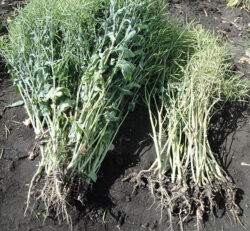
Features
Canola
Diseases
Clubroot management for sustainable canola production
Advances in the management and resistance stewardship of clubroot in canola.
November 29, 2023 By Donna Fleury
 From left: U of A researchers Dr. Stephen Strelkov and Dr. Sheau-Fang Hwang, and senior research associate Dr. Rudolph Fredua-Agyeman.
Photos courtesy of Plant Pathology Lab, U of A.
From left: U of A researchers Dr. Stephen Strelkov and Dr. Sheau-Fang Hwang, and senior research associate Dr. Rudolph Fredua-Agyeman.
Photos courtesy of Plant Pathology Lab, U of A. Clubroot in canola, caused by the pathogen Plasmodiophora brassicae, continues to challenge growers and researchers in Western Canada. Growers manage the disease mainly by planting clubroot-resistant canola varieties, but in recent years, new strains of the pathogen have emerged that can overcome this resistance and cause severe infections. Successful clubroot management requires resistance stewardship and an integrated approach, including management practices to reduce or suppress pathogen resting spore populations in the soil.
Researchers Sheau-Fang Hwang and Stephen Strelkov, from the Department of Agricultural, Food and Nutritional Science at the University of Alberta (U of A), along with many of their graduate students, are focused on finding more integrated approaches for managing the disease. The main driver of the various research projects is to develop techniques to reduce and suppress clubroot inoculum in fields to mitigate the impact of clubroot infection. Results from several research projects offer additional strategies that growers can consider for reducing risk and managing the disease.
“Growers often rely on resistant cultivars to manage the disease in their fields, which is a very key management tool, but not sufficient on its own,” says Hwang. “Resistance breakdown has appeared across all commercial varieties, which jeopardizes resistance as a clubroot management tool. As well, the pathogen keeps mutating, just like other diseases such as the COVID-19 virus, making it difficult to keep ahead. One of our most recent studies found the total number of known clubroot pathotypes has increased to 43, showing how quickly pathotype shifts are occurring and new pathotypes are being discovered. Plant breeders are expected to keep developing new cultivars, but it is getting more difficult to find resistance genes. With the rapidly shifting pathotypes, growers must manage the risk through integrated management strategies alongside genetic resistance tools.”
A soilborne pathogen, clubroot is very difficult to eradicate once established in a field. The pathogen favours acidic soils and good moisture conditions, with resting spores able to persist in the soil for more than 15 years. Therefore, researchers are focusing on developing techniques to reduce and suppress clubroot inoculum levels in fields to mitigate the impact of clubroot infection. Hwang and Strelkov have a number of PhD candidates and master’s students with projects focused on this goal. The main objectives are to determine the effects of clubroot severity on yield losses, determine the pathotype designation and distribution of a large number of P. brassicae field isolates collected from the Prairies, explore the use of lime formulations to suppress spore germination and examine how resistant canola and weedy species affect spore populations.

The roots were evaluated for the severity of clubroot symptoms on a 0-3 scale (left to right), where 0=no galling, 1= few small galls (small galls on less than one-third of the roots), 2 = moderate galling (small to medium galls in one-third to two-thirds of the roots), and 3 = severe galling (medium to large galls in more than two-thirds of the roots).
Techniques to reduce and suppress clubroot inoculum levels in fields
Andrea Botero-Ramírez, a U of A PhD candidate who recently completed her degree, evaluated the impact of clubroot on the yield of canola under field and greenhouse conditions. The two-year project examined the relationship between P. brassicae inoculum concentration and virulence on clubroot incidence and severity on canola cultivars with different levels of resistance. Three canola cultivars with different levels of resistance were inoculated with different quantities of P. brassicae inoculum and monitored for yield. The results showed that as disease severity index (DSI) increased, canola yield, pods per plant and 1,000-grain weight decreased in all cultivars. In the study, her analysis indicated that yield declined between 0.54 and 0.62 per cent for each one per cent increase in DSI under field conditions, resulting in a yield loss of between 54 to 62 per cent when the DSI was 100 per cent. In the greenhouse, yield declined by 0.9 to one per cent for each one per cent increase in disease. While the rate at which yield declined with increasing clubroot severity was very similar for all the cultivars tested, the susceptible cultivar had the greatest yield losses because it had the most severe disease.
Another study, led by Keisha Hollman, a U of A PhD candidate, characterized the pathotype designation and distribution of a large number of P. brassicae field isolates collected from the Prairies in 2019 and 2020. Previously, 36 unique pathotypes of P. brassicae had been documented on the Prairies based on their virulence on the Canadian Clubroot Differential (CCD) set, with pathotypes 3A, 3D, and 3H being predominant. The results of Hollman’s recent study identified 25 unique clubroot pathotypes, including seven new strains, of which six could overcome first-generation resistance. This finding brings the total number of known clubroot pathotypes to 43, showing how quickly pathotype shifts are occurring and new pathotypes are being discovered. While the pathotypes 3A, 3D, and 3 H remain among the most commonly identified, various other pathotypes were found that might be of concern in the future. The results of this study highlight the continued emergence of new P. brassicae pathotypes on canola, many of which are capable of causing clubroot on formerly resistant canola cultivars, emphasizing the need for careful resistance stewardship and integrated management of this disease.
Researchers have also evaluated lime products as a potential way to reduce clubroot severity under field conditions. Clubroot prefers acidic soils, so the application of lime to increase soil pH may reduce the disease. Nicole Fox, who completed her master’s at the U of A, compared varying rates of hydrated lime and limestone at different inoculum levels for clubroot control in 2017 and 2018. Overall, hydrated lime was the most effective, with high and moderate rates reducing clubroot severity compared to the low rate and control treatment. Although there were no significant differences in yield, the average index of disease (ID) was reduced from 47 per cent for the control treatment to 6.7 per cent at moderate (11.4 tonnes/ha) and four per cent at high application rates (12.7 tonnes/ha) in 2017. However, in 2018, several environmental factors resulted in little effect from a lime treatment, showing that results can vary, and optimal timing and rainfall are important. Applying moderate to high amounts of the powdered lime did result in canola plants that were still productive even if they were already infected by clubroot and also released fewer P. brassicae spores back into the soil.
A complementary study led by Brittany Hennig, another recently completed U of A master’s student, evaluated the effect of lime application and weed management on P. brassicae resting spore density, clubroot severity, crop yield and various growth parameters in clubroot-susceptible (CS) and clubroot-resistant (CR) canola cultivars in 2018 and 2019. The most notable effects on clubroot severity, yields and spore density were observed with hydrated lime and a CS cultivar. Although there were no significant effects on spore density in CR cultivar plots with hydrated lime or weed management, using these strategies collectively to limit infection and to create an unfavourable environment for the pathogen in heavily infested patches could help protect resistance and slow CR erosion. More research is required to better understand the impact of cruciferous and non-host weeds on P. brassicae inoculum levels and clubroot severity.
Resistance stewardship and an integrated disease management plan

Comparison of healthy canola and no clubroot (left) to clubroot infected canola (right).
Hwang and Strelkov note that the outcomes from these projects and others underway are showing multiple integrated management approaches required to keep clubroot inoculum low in fields. Growing clubroot-resistant cultivars on all acres is important as early infestations can often be overlooked, allowing spore concentrations to build to serious levels. Use recommended crop rotations of a minimum two-year break or longer from canola to reduce spore viability. Scout fields regularly with special attention to high traffic and high moisture areas. Consider managing patches and heavily infested zones with lime applications or additional years without canola, and consider fumigation where patches are small. Minimize soil movement within and between fields and sanitize equipment, especially in fields with new strains.
According to Hwang, “Continued surveillance for clubroot and the characterization of P. brassicae isolates for virulence and pathotype classification will be important, while breeding efforts should focus on multiple resistance genes, and tested against multiple virulence types. Although clubroot-resistant cultivars are still the most effective tool against clubroot, growers must include resistance stewardship and an integrated disease management plan for successful clubroot management and long-term canola production.”